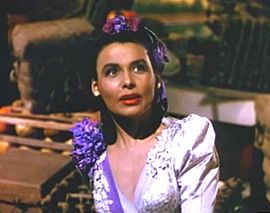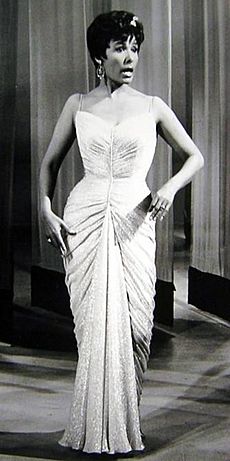Lena Horne facts for kids
Quick facts for kids
Lena Horne
|
|
|---|---|
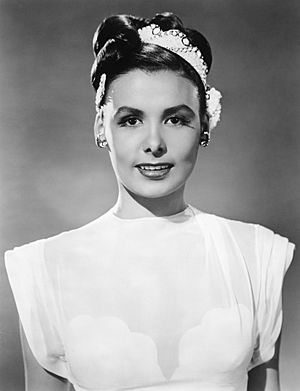
Publicity photo of Horne in 1946
|
|
| Born |
Lena Mary Calhoun Horne
June 30, 1917 Bedford–Stuyvesant, Brooklyn, New York, U.S.
|
| Died | May 9, 2010 (aged 92) New York City, U.S.
|
| Occupation |
|
| Years active | 1933–2003 |
| Spouse(s) |
Louis Jordan Jones
(m. 1937; div. 1944)Lennie Hayton
(m. 1947; died 1971) |
| Children | 2 |
| Relatives | Jenny Lumet (granddaughter) Jake Cannavale (great-grandson) |
| Musical career | |
| Origin | Harlem, New York City |
| Genres |
|
| Instruments | Vocals |
| Labels |
|
| Associated acts | |
Lena Mary Calhoun Horne (June 30, 1917 – May 9, 2010) was a famous American dancer, actress, singer, and civil rights activist. Her amazing career lasted over seventy years. She appeared in movies, on television, and in plays. Lena Horne started her career at just sixteen years old, joining the chorus line at the famous Cotton Club. She then became a popular nightclub performer before moving to Hollywood to become a movie star.
Horne was a strong supporter of human rights. She even took part in the historic March on Washington in August 1963. Later, she went back to performing in nightclubs and continued to work on television. She also released many popular music albums. She announced she would retire in March 1980. However, the very next year, she starred in a special one-woman show called Lena Horne: The Lady and Her Music. This show was a huge hit, running for more than 300 performances on Broadway. She then toured the country with the show, winning many awards. Horne kept recording music and performing sometimes into the 1990s. She stopped appearing in public around 2000.
Contents
Early Life of Lena Horne
Lena Horne was born in Bedford–Stuyvesant, Brooklyn, New York. Both sides of her family were African American. They were part of a well-educated, upper-class group of Black New Yorkers at that time.
Her father, Edwin Fletcher "Teddy" Horne Jr., was a hotel and restaurant owner. He was also a gambler. He left the family when Lena was three years old. He moved to an upper-middle-class African-American community in the Hill District of Pittsburgh, Pennsylvania. Lena lived with him there when she was 18, until she got married the next year. Her mother, Edna Louise Scottron, was an actress who traveled a lot with a Black theatre group. Lena's grandmother, Amelie Louise Ashton, was from modern Senegal. Lena was mostly raised by her grandparents, Cora Calhoun and Edwin Horne.
When Lena was five, she was sent to live in Georgia. For several years, she traveled with her mother. From 1927 to 1929, she lived with her uncle, Frank S. Horne. He was a dean at Fort Valley Junior Industrial Institute (now part of Fort Valley State University) in Fort Valley, Georgia. He later advised President Franklin Delano Roosevelt. After Fort Valley, Lena briefly moved to Atlanta with her mother. They returned to New York when Lena was twelve years old. She then went to St Peter Claver School in Brooklyn.
She later attended Girls High School, an all-girls public high school in Brooklyn. She left school without getting her diploma. At 18, she moved to her father's home in Pittsburgh. She stayed in the city's Little Harlem for almost five years. There, she learned music from local musicians like Billy Strayhorn and Billy Eckstine.
Lena Horne's Career
Road to Hollywood
In the fall of 1933, Lena Horne joined the chorus line at the famous Cotton Club in New York City. In the spring of 1934, she had a special role in the Cotton Club Parade. She was mentored by Adelaide Hall, a well-known performer. Horne first appeared on screen as a dancer in the musical short Cab Calloway's Jitterbug Party (1935). A few years later, Horne joined Noble Sissle's Orchestra. She toured with them and made her first records with Decca.
After her first marriage ended, Horne toured with bandleader Charlie Barnet from 1940 to 1941. She didn't like traveling so much. She left the band to work at the Cafe Society in New York. She took over from Dinah Shore as the main singer on NBC's popular jazz show The Chamber Music Society of Lower Basin Street. Horne recorded with the show's bandleaders in June 1941 for RCA Victor. Horne left the show after only six months. She was hired by Felix Young, a former manager, to perform in a Cotton Club-style show in Hollywood.
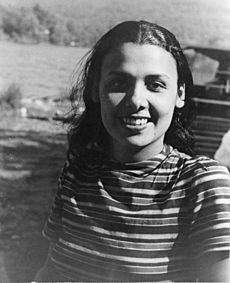
Horne had already been in two low-budget movies. These were The Duke is Tops (1938) and a short film called Boogie Woogie Dream (1941). Her songs from Boogie Woogie Dream were later released as individual "soundies." Horne made her Hollywood nightclub debut in January 1942. A few weeks later, she signed a contract with Metro-Goldwyn-Mayer (MGM), a major movie studio. In November 1944, she was featured in an episode of the radio series Suspense. She played a fictional nightclub singer with a big speaking role. In 1945 and 1946, she sang with Billy Eckstine's Orchestra.
She made her first MGM movie in Panama Hattie (1942). She also sang the famous title song of Stormy Weather (1943) for 20th Century Fox. This movie was loosely based on the life of Adelaide Hall. Horne appeared in several MGM musicals. These included Cabin in the Sky (1943), which had an all-Black cast. However, she was not given many leading roles because of her race. Her films often had to be re-edited for theaters that would not show movies with Black performers. Because of this, most of Horne's movie appearances were stand-alone songs or scenes. They could be easily cut without changing the story.
One scene from Cabin in the Sky was cut before the movie was released. It showed Horne singing "Ain't It the Truth" while taking a bubble bath. Censors thought it was too suggestive. This scene and song are shown in the film That's Entertainment! III (1994). Horne also talked about why the scene was deleted. Horne was the first African-American person chosen to be on the Screen Actors Guild board of directors.
In Ziegfeld Follies (1946), she performed the song "Love." Horne wanted the role of Julie LaVerne in MGM's movie version of Show Boat (1951). She had already played the role in a part of Show Boat shown in Till the Clouds Roll By. But she lost the part to Ava Gardner, who was a friend in real life. Horne believed this was because of rules that banned interracial relationships in films. However, MGM sources said she was never considered for the role. In the documentary That's Entertainment! III, Horne said that MGM executives made Gardner practice singing using Horne's recordings. This upset both actresses. In the end, Gardner's singing voice was dubbed by another actress for the movie.
Changes in Her Career
Horne became unhappy with Hollywood. She started to focus more on her nightclub career. She only made two major appearances for MGM during the 1950s. These were Duchess of Idaho (1950) and the musical Meet Me in Las Vegas (1956). She said she was "tired of being typecast as a Negro who stands against a pillar singing a song. I did that 20 times too often." She faced difficulties in the 1950s because of her past connections to certain groups. She later said she no longer supported those groups.
She returned to the screen, playing Claire Quintana in the film Death of a Gunfighter (1969). This was her first serious acting role where her race was not a main part of the story. She later appeared on screen two more times. She played Glinda in The Wiz (1978), which was directed by her son-in-law Sidney Lumet. She also co-hosted the MGM movie review That's Entertainment! III (1994). In this film, she talked about how she was treated unfairly by the studio.
After leaving Hollywood, Horne became one of the top nightclub performers. She performed in clubs and hotels across the U.S., Canada, and Europe. These included the Sands Hotel in Las Vegas and the Waldorf-Astoria in New York. In 1957, a live album called Lena Horne at the Waldorf-Astoria became the best-selling record by a female artist for RCA Victor at that time. In 1958, Horne was the first African-American woman to be nominated for a Tony Award. This was for "Best Actress in a Musical" for her role in the musical Jamaica.
From the late 1950s through the 1960s, Horne was a regular on TV variety shows. She appeared many times on shows like Kraft Music Hall, The Ed Sullivan Show, and The Dean Martin Show. She also had her own U.S. television special in 1969. During this time, artist Pete Hawley painted her portrait for RCA Victor.
In 1970, she starred with Harry Belafonte in the TV special Harry & Lena. In 1973, she starred with Tony Bennett in Tony and Lena. Horne and Bennett later toured together. Horne also appeared on shows like The Flip Wilson Show, The Muppet Show, Sesame Street, and Sanford and Son in the 1970s. She also appeared on The Cosby Show in 1985 and A Different World in 1993. In the summer of 1980, Horne, who was 63 and planned to retire, started a series of benefit concerts. These concerts were called her farewell tour. But her retirement lasted less than a year.
In May 1981, Lena Horne was booked for a four-week show at the Nederlander Theatre in New York City. The show was a huge success and ran for a full year. It earned Horne a special Tony award and two Grammy Awards for the recording of her show Lena Horne: The Lady and Her Music. The Broadway show closed on Horne's 65th birthday, June 30, 1982. She then toured with The Lady and Her Music in 41 cities in the U.S. and Canada. It also played in London and Stockholm, Sweden. In 1989, she received the Grammy Lifetime Achievement Award.
In 1995, a live album of Horne's Supper Club performance was released. It won a Grammy Award for Best Jazz Vocal Album. In 1998, Horne released another studio album, Being Myself. After this, Horne retired from performing and mostly stayed out of public view. She did return to the recording studio in 2000 to sing on Simon Rattle's Classic Ellington album.
Civil Rights Activism
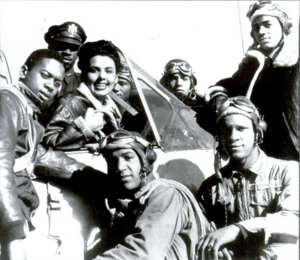
Lena Horne was deeply involved in the Civil Rights Movement. In 1941, she sang at Café Society, which was New York City's first integrated venue (meaning people of all races could attend). She also worked with Paul Robeson. During World War II, she entertained soldiers for the USO. She refused to perform for segregated audiences. She also refused to perform for groups where German prisoners of war were seated in front of Black servicemen. Because the U.S. Army would not allow mixed audiences, she performed for a mixed audience of Black U.S. soldiers and white German POWs. She saw that the Black soldiers were forced to sit in the back. So, she walked off the stage to the first row where the Black troops were seated and performed with the Germans behind her. After leaving the USO in 1945, Horne paid for tours of military camps herself.
She attended a NAACP rally with Medgar Evers in Jackson, Mississippi. This was the weekend before Evers was assassinated. She was also at the March on Washington. She spoke and performed for the NAACP, the S.N.C.C., and the National Council of Negro Women. She also worked with Eleanor Roosevelt to try and pass laws against lynching. In 1983, the NAACP gave her the Spingarn Medal.
Horne was a registered Democrat. On November 20, 1963, she visited John F. Kennedy at The White House. This was just two days before his assassination.
Personal Life
Lena Horne married Louis Jordan Jones in January 1937 in Pittsburgh. Their daughter, Gail (later known as Gail Lumet Buckley, a writer), was born in December 1937. They also had a son, Edwin Jones (1940–1970), who died from kidney disease. Horne and Jones separated in 1940 and divorced in 1944. Horne's second marriage was to Lennie Hayton. He was a music director and arranger at MGM. They married in December 1947 in Paris. They separated in the early 1960s but never divorced. He died in 1971. In her autobiography Lena, Horne talked about the challenges she and her husband faced as an interracial couple. She later said in an interview that she married Hayton to help her career and break racial barriers in show business. She added that she "learned to love him very much."
Screenwriter Jenny Lumet is Horne's granddaughter. Jenny is known for her screenplay Rachel Getting Married. She is the daughter of filmmaker Sidney Lumet and Horne's daughter Gail. Horne's great-grandchildren include Jake Cannavale.
Horne was Catholic. From 1946 to 1962, she lived in St. Albans, Queens, New York. This was a neighborhood where many successful African Americans lived. Her neighbors included Count Basie and Ella Fitzgerald. In the 1980s, she moved into a co-op building in New York City.
Death
Lena Horne died from heart problems on May 9, 2010. Her funeral was held at St. Ignatius Loyola Church in New York. Thousands of people attended, including many famous performers. Her remains were cremated.
Legacy
In 2003, ABC announced that Janet Jackson would play Horne in a TV movie about her life. After a controversy involving Jackson in 2004, Horne reportedly asked that Jackson be removed from the project. Jackson's representatives said she left willingly after Horne and her daughter asked her not to take part. Oprah Winfrey later said she might produce the movie herself, with Alicia Keys playing Horne.
In January 2005, Blue Note Records announced a collection of rare and unreleased recordings by Horne. The album, called Seasons of a Life, was released on January 24, 2006. In 2007, Horne was played by Leslie Uggams (as the older Lena) and Nikki Crawford (as the younger Lena) in the stage musical Stormy Weather. In 2011, actress Ryan Jillian played Horne in a one-woman show called Notes from A Horne. The 83rd Academy Awards honored Horne with a tribute by actress Halle Berry in February 2011.
In 2018, a forever stamp featuring Horne was issued. This made Horne the 41st person honored in the Black Heritage stamp series.
In June 2021, the Prospect Park bandshell in Brooklyn was renamed the Lena Horne Bandshell. This honored Horne, who was born in Brooklyn, and showed support for the Black community.
The Nederlander Organization announced in June 2022 that Broadway's Brooks Atkinson Theatre would be renamed after her. The theatre's new sign was revealed on November 1, 2022. The theatre is now called the Lena Horne Theatre. This means Horne is the first Black woman to have a Broadway theater named after her.
Awards
Grammy Awards
| 1961 | Lena Horne at the Sands | Best Vocal Performance Album, Female | Nominated |
| 1962 | Porgy and Bess | Best Solo Vocal Performance, Female | Nominated |
| 1981 | Lena Horne: The Lady and Her Music | Best Pop Vocal Performance, Female | Won |
| Lena Horne: The Lady and Her Music | Best Cast Show Album | Won | |
| 1988 | The Men in My Life | Best Jazz Vocal Performance | Nominated |
| "I Won't Leave You Again" (with Joe Williams) | Best Jazz Vocal Performance, Duo or Group | Nominated | |
| 1989 | Lifetime Achievement Award | Won | |
| 1995 | An Evening with Lena Horne | Best Jazz Vocal Performance | Won |
Other Awards
| Year | Organization | Category | Result | Notes |
|---|---|---|---|---|
| 1957 | Tony Awards | Best Actress | Nominee | Jamaica |
| 1980 | Howard University | Honorary doctorate | Honored | |
| 1980 | Drama Desk Awards | Outstanding Actress – Musical | Won | Lena Horne: The Lady and Her Music |
| 1980 | New York Drama Critics Circle Awards | Special Citation | Won | Lena Horne: The Lady and Her Music |
| 1981 | Tony Awards | Special Citation | Won | Lena Horne: The Lady and Her Music |
| 1984 | John F. Kennedy Center for the Performing Arts |
Kennedy Center Honors | Won | For extraordinary talent, creativity, and perseverance |
| 1985 | Emmy Award | Lena Horne: The Lady and Her Music | Nominee | |
| 1987 | American Society of Composers, Authors and Publishers |
The ASCAP Pied Piper Award | Won | Given to entertainers who have made significant contributions to words and music |
| 1994 | Sammy Cahn Lifetime Achievement Award | Songwriters Hall of Fame | Won | |
| 1997 | Society of Singers | Society of Singers Lifetime Achievement Award | Won | for "whom singers are awarded for their contribution to the world of music along with their dedicated efforts to benefit the community and worldwide causes" |
| 1999 | NAACP Image Award | Outstanding Jazz Artist | Won | |
| 2006 | Martin Luther King, Jr. National Historic Site |
International Civil Rights Walk of Fame | Inducted | |
| ? | Hollywood Chamber of Commerce | Hollywood Walk of Fame | Won | Honor (motion pictures) |
| ? | Hollywood Chamber of Commerce | Hollywood Walk of Fame | Won | Honor (recordings) |
Filmography
Movies
- Cab Calloway's Jitterbug Party (1935, short film)
- The Duke Is Tops (1938)
- Panama Hattie (1942)
- Cabin in the Sky (1943)
- Stormy Weather (1943)
- Thousands Cheer (1943)
- I Dood It (1943)
- Swing Fever (1943)
- Boogie-Woogie Dream (1944, short film from 1941)
- Broadway Rhythm (1944)
- Two Girls and a Sailor (1944)
- Studio Visit (1946) (short film; with cut scene from Cabin in the Sky)
- Till the Clouds Roll By (1946)
- Ziegfeld Follies (1946)
- Words and Music (1948)
- Some of the Best (1949, short film)
- Duchess of Idaho (1950)
- Meet Me in Las Vegas (1956)
- The Heart of Show Business (1957, short film)
- Now! (1965) (short film, voice only)
- Death of a Gunfighter (1969)
- The Wiz (1978)
- That's Entertainment! III (1994)
- Strange Frame (old footage, 2012)
Television Shows
- What's My Line? (as Mystery Guest, September 27, 1953)
- Ed Sullivan Show (January 6, 1957)
- "What's My Line?" (as Mystery Guest, March 2, 1958)
- The Judy Garland Show (as herself, October 13, 1963)
- The Perry Como Show (as herself, March 5, 1965)
- Sesame Street (as herself, Episode #5.1, November 19, 1973)
- Sanford & Son ("A Visit from Lena Horne" as herself, January 12, 1973)
- The Muppet Show (as herself, 1976)
- Sesame Street (as herself, Episode #7.76, March 15, 1976)
- The Cosby Show ("Cliff's Birthday" as herself, May 9, 1985)
- A Different World ("A Rock, a River, a Lena" as herself, July 1993)
Discography
Albums
- Moanin' Low (RCA Victor, 1942)
- Classics in Blue (Black & White, 1947)
- Lena Horne Sings (Tops, 1953)
- It's Love (RCA Victor, 1955)
- Lena Horne (Tops, 1956)
- Jamaica with Ricardo Montalban (RCA Victor, 1957)
- Stormy Weather (RCA Victor, 1957)
- Lena Horne at the Waldorf Astoria (RCA Victor, 1957)
- Lena and Ivie with Ivie Anderson (Jazztone, 1957)
- I Feel So Smoochie (Lion, 1958)
- Give the Lady What She Wants (RCA Victor, 1958)
- Songs by Burke and Van Heusen (RCA Victor, 1959)
- Porgy & Bess with Harry Belafonte (RCA Victor, 1959)
- Lena Horne at the Sands (RCA Victor, 1961)
- L' inimitable Lena Horne with Phil Moore (Explosive, 1962)
- Lena...Lovely and Alive (RCA Victor, 1962)
- Lena on the Blue Side (RCA Victor, 1962)
- Fabulous! (Baronet, 1962)
- Here's Lena Now! (20th Century Fox, 1963)
- Swinging Lena Horne (Coronet, 1963)
- Lena Horne Sings Your Requests (MGM, 1963)
- Lena Like Latin (CRC Charter 1963)
- Gloria Lynne & Lena Horne (Coronet, 1963)
- The Incomparable Lena Horne (Tops, 1963)
- Feelin' Good (United Artists, 1965)
- Merry from Lena (United Artists, 1966)
- Soul (United Artists, 1966)
- Lena in Hollywood (United Artists, 1966)
- The Horne of Plenty (World Record Club 1966)
- Dinah Washington: A Memorial Tribute with Ray Charles, Sarah Vaughan (Coronet, 1967)
- My Name Is Lena (United Artists, 1967)
- Lena & Gabor with Gábor Szabó (Skye, 1970)
- Harry & Lena with Harry Belafonte (RCA, 1970)
- Nature's Baby (Buddah, 1971)
- Lena (Ember, 1971)
- Lena & Michel with Michel Legrand (RCA Victor, 1975)
- Lena: A New Album (RCA, 1976)
- The Exciting Lena Horne (Springboard, 1977)
- Love from Lena (Koala, 1979)
- Lena Horne: The Lady and Her Music (Qwest, 1981)
- A Date with Lena Horne 1944 (Sunbeam, 1981)
- The One & Only (Polydor, 1982)
- Standing Room Only (Accord, 1982)
- The Men in My Life (Three Cherries, 1988)
- Lena (Prestige, 1990)
- We'll Be Together Again (Blue Note, 1994)
- An Evening with Lena Horne (Blue Note, 1995)
- Cabin in the Sky (TCM, 1996)
- Wonderful Lena (Sovereign, 1997)
- Being Myself (Blue Note, 1998)
- The Complete Black and White Recordings (Simitar, 1999)
- The Classic Lena Horne (RCA, 2001)
- Stormy Weather (Bluebird, 2002)
- Seasons of a Life (Blue Note, 2006)
Singles
- "That's What Love Did to Me"/"I Take to You" (Decca)
- "Stormy Weather" (1943)
- "One for My Baby (and One More for the Road)" (1945) No. 21 U.S. Pop
- "'Deed I Do" (1948) No. 26 U.S. Pop
- "Love Me or Leave Me" (1955) No. 19 U.S. Pop
- "Now!" (1963) No. 92 U.S. Pop
- "Watch What Happens" with Gabor Szabo (1970) No. 119 U.S. Pop
Images for kids
See also
 In Spanish: Lena Horne para niños
In Spanish: Lena Horne para niños


